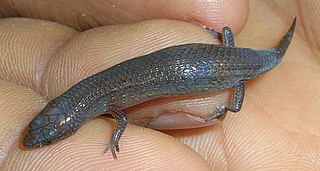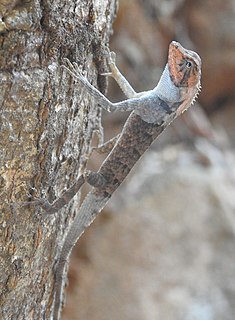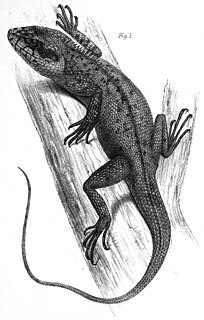
Calotes is a genus of lizards in the draconine clade of the family Agamidae. The genus contains 25 species. Some species are known as forest lizards, others as "bloodsuckers" due to their red heads, and yet others as garden lizards.

Harpesaurus is a genus of lizards in the family Agamidae. The genus is endemic to Indonesia.
Pseudocalotes is a genus of agamid lizards endemic to Southeast Asia.

Ristella is a genus of skinks endemic to the Western Ghats of southwestern India. They are commonly known as cat skinks because of their retractile claws. This genus can be instantly identified by the presence of only four fingers in forelimbs in all the species. All the members look more or less similar and are drab dark brown to blackish in complexion with paler undersides. This poorly known groups of lizards are diurnal, insectivorous, terrestrial to semi fossorial in habits. They inhabit deep leaf-litter and grasslands in montane forests and rainforests.

Bronchocela cristatella, also known as the green crested lizard, is a species of agamid lizard endemic to Southeast Asia.

Monilesaurus ellioti, or Elliot's forest lizard, is a species of arboreal, diurnal, lizard in the family Agamidae, endemic to the Western Ghats, India.

Calotes grandisquamis, the large-scaled forest lizard, is an arboreal, diurnal, insectivorous agamid lizard found in the evergreen rainforests of the Western Ghats of India; distributed from Agumbe to Agasthyamalai Hills.
Calotes maria, called commonly the Khasi Hills forest lizard, is a species of lizard in the family Agamidae. The species is endemic to South Asia.

Monilesaurus rouxii, commonly known as Roux's forest lizard, Roux's forest calotes, or the forest blood sucker, is a species of arboreal, diurnal, agamid lizard, which is endemic to hills of peninsular India. In July 2018, it was proposed that the species should be transferred to the new genus Monilesaurus.

Coryphophylax subcristatus, the short-crested bay island forest lizard, is an agamid lizard found in the Andaman and Nicobar Islands. It does not occur south of 7° 11' 58.94" N.

Draco dussumieri the Indian flying lizard, Western Ghats flying lizard, or southern flying lizard, is a species of agamid lizard capable of gliding from tree to tree. It is found principally in the Western Ghats and some other hill forests of Southern India. They are almost completely arboreal, found on trees in forests and adjoining palm plantations where they climb trees to forage for insects and glide to adjoining trees by expanding the patagium, loose skin on the sides of the body which are supported by elongated ribs to act as wings. The skin on the sides of the neck are also extended to the sides using the hyoid bones of the tongue to support them. During the breeding season males maintain small territories which they defend from other males while courting females. Males have a more colourful patagium than females and they prominently extend their yellow dewlaps forward in display. Although living almost their entire lives on the trees, females descend to the ground to lay eggs in soil. This is the species with the westernmost distribution within the genus Draco, the majority of species occurring in Southeast Asia.

Pseudocalotes austeniana, also known commonly as the Abor Hills agama or Annandale's dragon, is a rare species of lizard in the family Agamidae. The species is endemic to Asia.

Otocryptis beddomii, commonly known as the Indian kangaroo lizard, is a diurnal, terrestrial, insectivorous agamid lizard, endemic to the Western Ghats of South India.

Pseudocalotes kakhienensis, the Kakhyen Hills spiny lizard, is a species of agamid lizard found in southern China, Myanmar, India, and northern Thailand. Type locality: Ponsee, Western Yunnan.

Dendrelaphis grandoculis commonly called as the large-eyed bronzeback is a species of Colubrid snake endemic to the Western Ghats of southwestern India.
Dibamus nicobaricum is a species of lizard found in the Nicobar Islands of India.

Dendrelaphis is a genus of colubrid snakes, distributed from Pakistan, India and southern China to Indonesia, Timor-Leste, the Philippines, Australia, New Guinea and the Solomon Islands. There are over forty described species. Asian species are known as bronzebacks, while the Australo-Papuan species are simply called treesnakes. All are non-venomous and entirely harmless to humans.
Microauris is a monotypic genus of agamid lizard. Its only species is Microauris aurantolabium, also known as the small-eared dragon or orange-lipped forest lizard, found in the forests of the southern Western Ghats and is currently known from the Kalakkad Mundanthurai Tiger Reserve. The species was formerly included in Pseudocalotes andamanensis of the Andaman Islands, but recognized as distinct in 2008. It was also classified under Calotes until 2018, where it was transferred to its own genus, Microauris, on the basis of its divergence from Calotes.

The Draconinae are a subfamily of reptiles in the family Agamidae found in southern Asia and Oceania. Some taxonomists believe these genera belong to the subfamily Agaminae.















